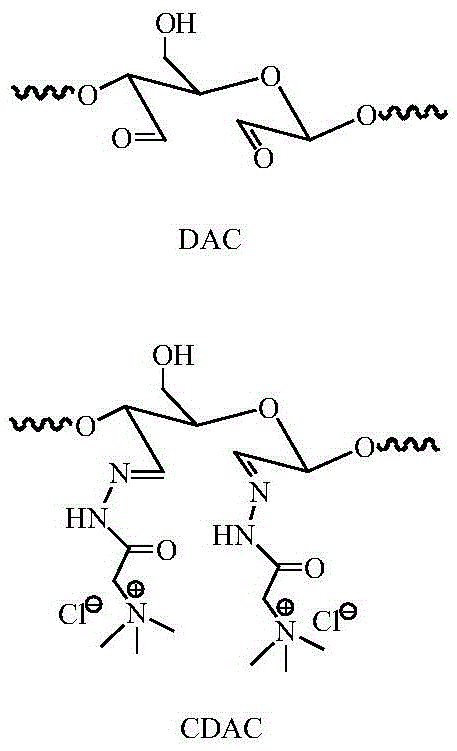Preparation method of cellulose nanocrystal and chitosan composite membrane
A technology of nanocrystals and cellulose, which is applied in the field of preparation of cellulose nanocrystals/chitosan composite membranes, can solve the problems of uneven dispersion and poor mechanical properties, and achieve simple process, less pollution, good mechanical properties and water resistance The effect of swelling properties
- Summary
- Abstract
- Description
- Claims
- Application Information
AI Technical Summary
Problems solved by technology
Method used
Image
Examples
preparation example Construction
[0017] (4) Preparation of CDAC / chitosan composite film.
[0018] Each performance of CDAC / chitosan composite membrane of the present invention can adopt following index to detect:
[0019] The cellulose nanocrystals before and after modification were diluted to a solute mass fraction of 0.5% and dispersed ultrasonically, and a drop of the solution was dropped on a copper grid and dried. Under the condition of an accelerating voltage of 80KV, the morphology was observed with a transmission electron microscope (JEM-2100, JEOL Ltd.).
[0020] Put the CDAC / chitosan composite film into a constant temperature and humidity chamber (temperature is 25°C, relative humidity is 65%) to balance for 48h, and cut into strips with a width of 1cm; Calculate the average value of 5 points to test the thickness of the film, and use a computer-controlled universal material testing machine (WDW-20 Shanghai Hualong Testing Instrument Co., Ltd.) to measure the tensile breaking strength and elongatio...
Embodiment 1
[0025] (1) Add 1 part of microcrystalline cellulose to 20 parts of 64% concentrated sulfuric acid, mechanically stir at 45°C and 600r / min for 1 hour, and centrifuge at 10000r / min at high speed to collect the upper layer of white CNC sol, dialyze for 3 days and then add 0.1N sodium hydroxide solution adjusts the pH of the sol to 6.5;
[0026] (2) Add 3 parts of sodium periodate to the CNC sol prepared in step (1), react at 45°C for 5 hours in the dark; add 3 parts of ethylene glycol to react for 1 hour and dialyze for 5 days to obtain dialdehyde cellulose Nanocrystalline (DAC) sol;
[0027] (3) 4 parts of Geraldt reagent T were added to the DAC sol prepared in step (3), and reacted at 60°C for 5 hours; after dialysis for 5 days, a cationized cellulose nanocrystal (CDAC) sol was obtained;
[0028] (4) 1 part of chitosan is dissolved in 100 parts of 1% (w / v) acetic acid solution at room temperature, 4.5 parts of CDAC sol prepared by step (3) are mixed with chitosan acetic acid s...
Embodiment 2
[0030] (1) Add 1 part of microcrystalline cellulose to 20 parts of 64% concentrated sulfuric acid, mechanically stir at 45°C and 600r / min for 1 hour, and centrifuge at 10000r / min at high speed to collect the upper layer of white CNC sol, dialyze for 3 days and then add 0.1N sodium hydroxide solution adjusts the pH of the sol to 6.5;
[0031] (2) Add 3 parts of sodium periodate to the CNC sol prepared in step (1), react at 45°C for 5 hours in the dark; add 3 parts of ethylene glycol to react for 1 hour and dialyze for 5 days to obtain dialdehyde cellulose Nanocrystalline (DAC) sol;
[0032] (3) 4 parts of Geraldt reagent T were added to the DAC sol prepared in step (3), and reacted at 60°C for 5 hours; after dialysis for 5 days, a cationized cellulose nanocrystal (CDAC) sol was obtained;
[0033] (4) 1 part of chitosan is dissolved in 100 parts of 1% (w / v) acetic acid solution at room temperature, and 9 parts of CDAC sols prepared in step (3) are mixed evenly with chitosan ace...
PUM
 Login to View More
Login to View More Abstract
Description
Claims
Application Information
 Login to View More
Login to View More - R&D
- Intellectual Property
- Life Sciences
- Materials
- Tech Scout
- Unparalleled Data Quality
- Higher Quality Content
- 60% Fewer Hallucinations
Browse by: Latest US Patents, China's latest patents, Technical Efficacy Thesaurus, Application Domain, Technology Topic, Popular Technical Reports.
© 2025 PatSnap. All rights reserved.Legal|Privacy policy|Modern Slavery Act Transparency Statement|Sitemap|About US| Contact US: help@patsnap.com



